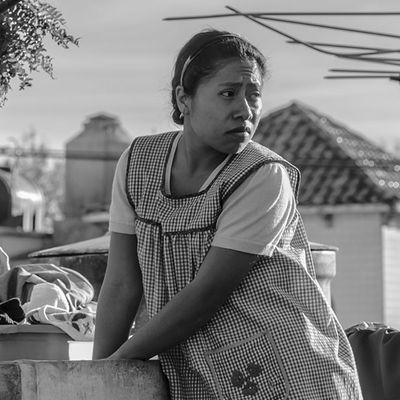
Before being cast in the starring role of writer-director Alfonso Cuarón’s Mexico City–set period drama Roma, Yalitza Aparicio had not only never acted before, she had never contemplated acting before. Perhaps more crucially, she had to reassure her family that meeting with the film’s production executives wouldn’t result in her being kidnapped by a human-trafficking ring. Moreover, the preschool teacher, a native of Tlaxiaco, Oaxaca (population: 17,450), who holds a degree in education, wound up auditioning almost as an afterthought.
Aparicio accompanied her sister to the casting call, then ended up taking her place when her sister — who was pregnant at the time — suddenly got cold feet. And even then, Aparicio says it was curiosity and not the pursuit of stardom that compelled her to stick with it, submitting to a video-recorded screen test that involved answering personal questions — such as Have you ever fallen in love? Has your heart ever been broken? Do you believe in God? — rather than enact written dialogue.
Still, word she’d landed the part came as a shock. “It was a huge surprise,” Aparicio tells me through an interpreter, over cappuccino at a posh West Hollywood hotel. “It was never my goal to actually get the role. I was just curious at every stage about the process.”
Aparicio, 24, arrives onscreen as a quiet revelation portraying Cleo, a domestic servant for a middle-class family with four young children in the politically tumultuous early ’70s. The autobiographical black-and-white film, which is based on Cuarón’s upbringing in the Roma suburb of Mexico City, premiered at the Venice Film Festival in August (winning the fest’s top prize, the Golden Lion), bowled over critics at the Telluride and Toronto International Film Festivals (its current Rotten Tomatoes standing is 99 percent “fresh”), and has been selected as the Mexican entry for Best Foreign Language film at next year’s Academy Awards. (As part of an unusual release strategy, Netflix will give Roma a four-week run in theaters beginning November 21 before streaming the film on its platform on December 14.) But it’s fair to say that Cuarón’s self-described passion project — which took 15 years to reach the screen and is now widely considered to be a Best Picture front runner — wouldn’t have been made without Aparicio.
Cleo, it turns out, is based on the director’s beloved real-life live-in housekeeper and nanny Liboria “Libo” Rodriguez, an indigenous Mixtec woman also from Oaxaca state who played a profound role in helping to bring him up and to whom Roma is dedicated. So Cuarón — the visionary filmmaker behind such acclaimed titles as Children of Men and Y Tu Mamá También, who won a Best Director Academy Award in 2014 for Gravity — put out a casting dragnet across Mexico in search of the perfect person to play Libo’s cinematic counterpart, ultimately auditioning some 3,000 women, both professional and nonprofessional actresses: An exhaustive and logistically thorny process that took over a year.
“Alfonso was trying to re-create members of his own family; they needed to look how he remembered them; also they needed to feel right, so he was very keen on the vibe he got from them,” Roma producer Gabriela Rodriguez says. “In the beginning, Alfonso thought, I’m sure we’ll find an indigenous woman in Mexico City; it’s got the biggest indigenous population in Mexico. But he felt those women had lost the rural aspect that Cleo and his own Libo had when they moved there. It had to be someone with a more fresh-off-the-boat quality. Plus, he was adamant that it couldn’t be like your traditional soap-opera-ish performance. For him, it needed to be authentic.”
She continued: “So it’s like, Where do you find these communities? How do you get access to these communities that have never had casting sessions? How do you explain to them that we’re a real production? It took writing letters, talking to mayors of towns, to cultural administrators. I mean, forget about getting people to come in — just to do casting sessions in certain communities was really hard!”
Further muddying the process, the production covered up the fact that Alfonso Cuarón would be directing the film — then described as “an intimate sort of family project in Mexico City” — the thinking being that his new level of fame after the blockbuster success of Gravity (which took in $732 million worldwide) would likely taint or complicate the casting process. “They didn’t say who the director was or for what movie we’d be auditioning,” Aparicio recalls. “They just said they were looking for women of any body type and age. That and just the name of the production company was all.”
Not that Cuarón’s announced attachment would have held much sway for Aparicio, who admits that she was familiar with fellow Mexican director Guillermo del Toro’s filmic oeuvre, but totally ignorant of the man who would hire her. “I knew nothing at all about Alfonso,” says Aparicio. “I had seen none of his films — which actually helped because it meant I was less nervous to meet him. When I did, we sort of sat together, and it was more like we were two old friends who had met up after a really long time and caught up with each other about our lives.”
“It was like love at first sight,” Gabriela Rodriguez says.
(At a Q&A at the British Film Institute last month, Cuarón recalled first regarding Aparicio with a mixture of “relief and fear.” “Relief because we found the right person,” he said. “But fear — what if she said no? The movie wouldn’t work. Her family were afraid that the casting call was human trafficking. They said that ‘casting is not normal.’ The scary thing about that statement is that casting is not normal in Mexico but human trafficking is. That is the reality of Mexico.”)
In keeping with the unorthodox nature of Aparicio’s casting, Roma’s 110-day production schedule similarly colored outside the lines of how most movies are made. Cuarón chose to shoot chronologically, giving the actors only the pages of the screenplay that were being shot on a given day. In an attempt to capture a kind of filmic naturalism, none of them knew the ultimate fate of their characters or how the plot would conclude. Aparicio, for her part, remembers being kept off balance, not knowing how the other actors were going to respond to the dialogue she recited — or what they were going to say in return. “I did not know at all what anybody’s reaction was going to be,” she says. “This was true of every single scene. Sometimes, for example, as [Cuarón] was telling me what I was supposed to do, he would share what other people were going to say. But then, when he was rolling the scene, it would turn out that the people were saying things that were completely different.”
One scene in which Cleo informs her ex-boyfriend Fermín (played by Jorge Antonio Guerrero) that she is pregnant with his child — an outcome to which he responds with unexpected fury — united the production in protective feelings for their lead actress. “That scene shocked us all. The entire crew was in horror,” Rodriguez says. “The PAs and the runners came to me and were like, ‘This is not okay. I don’t know if I can look at that guy again, the way he just spoke to her.’ Everybody was really hurt. So it not only affected Yalitza; it affected us all.”
Oscars prognosticators have already begun handicapping Aparicio’s chances of landing a Best Actress nomination, something only three other Latina actresses — Salma Hayek in 2002’s Frida, Catalina Sandino Moreno in Maria Full of Grace (2004), and Fernanda Montenegro in Central Station (1998) — have accomplished to date. But when I ask Aparicio what it means to her that people are already discussing her and Roma in terms of Academy Awards, she’s dispassionate, almost stoic.
“I’ve only seen them on TV,” she says. “I don’t really have any relationship to the Oscars other than experiencing them as a spectator.”





